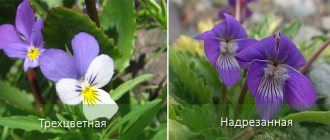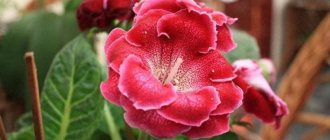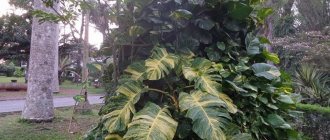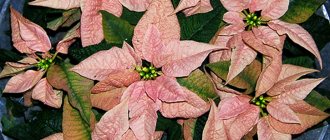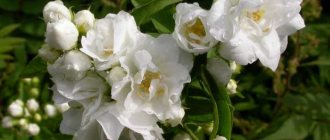And there are few whole inflorescences
When choosing begonia for your garden or home, you need to understand that the thematic plant can be decorative-flowering or decorative-deciduous. The latter do not bloom, but delight with their foliage.
It is almost always asymmetrical and comes in different colors:
- Emerald;
- Maroon;
- Emerald speckled;
- Olive metallic;
- Olive;
- Turquoise;
- Violet;
- Pink, etc.
Begonia leaves contain up to four different colors, which create expressive patterns that are akin to the charm of butterflies.
Brief description of red leaf begonia
Begonia redleaf got its name due to the red color of the inside of the leaves. The plant has a short, light green color, on which 5 cm leaves grow. The foliage is glossy, round in shape, green above and intensely red below.
It blooms with small pink flowers in mid-summer. If you care for it correctly, you can get a bushy beautiful plant, 40 centimeters high.
In addition to the red-leaved begonia, you can see a bright red variety of the plant in the flower beds. The bush grows up to one meter. Blooms during spring and summer. Bush begonia has graceful stems, dark green leaves with red edges and dull red undersides.
Bright red begonia blooms with coral-red flowers, with corymbose inflorescences. This variety is recommended to be planted in humus-enriched soil with good mulching.
Description and characteristics of the plant
Red begonia is a perennial ornamental flowering tuberous plant of the Begoniaceae family, which is distinguished by beautiful, large flowers of rich red color. The flowers of the crop, about 10 cm in diameter, consist of very delicate, slightly corrugated petals. Their aroma is delicate and sweet.
Did you know? The asteroid (943) Begonia, discovered in 1920, is named after the begonia plant.
In indoor conditions, begonia can reach a height of 20–40 cm. The leaves of the indoor plant are fragile, patterned, dark green in color, harmoniously combined with large, voluminous flowers. The flowering of the crop lasts for several months, starting from May and ending in October, while the flowering of each peduncle lasts 2-3 weeks. The root system is presented in the form of medium-sized tubers and thin root processes extending from them.
Reproduction
Fista propagates only by cuttings and leaves, while for bright red begonia propagation by cuttings, seeds and dividing the bush is suitable. The best time for propagation is early spring, when begonia begins to emerge from dormancy.
Fista propagation by cuttings occurs as follows:
- cut a cutting 6-9 cm long from the root system and dip it in a preparation that helps good rooting.
- plant it in a pot with a diameter of no more than 10 cm with a damp sandy-peaty substrate and drainage holes.
- cover with a glass jar and place in a warm room with abundant but diffused sunlight.
- after two weeks they feed with fertilizers, and after a month they remove the jar and water it abundantly.
The method of deciduous propagation looks like this: the leaf is cut with a knife along the large veins on the reverse side, then it is placed on a substrate, strengthened with small pebbles so that the surface of the leaf fits tightly to the ground, and placed in a warm place. Over time, roots form at the cut sites, and small seedlings form on the upper side of the leaf.
Domestic begonia is propagated by cuttings in the following sequence:
- cut several cuttings with 3-5 leaves.
- after treating the sections with crushed coal, they are planted in a leaf-peat-sand substrate (all components must be taken in equal parts).
- for a month, while the cuttings take root, water them, maintain a temperature of +20 degrees and high air and soil humidity, and shade them from the sun.
- a month later, when the seedlings take root, they are planted in separate pots with a similar substrate.
The most labor-intensive way to propagate bright red begonia is by seeds. They are sown in February-March directly on the surface of the soil, without covering them with soil, then the container with them is placed on the windowsill and covered with glass. Watering is carried out from a spray bottle or from a saucer, maintaining a temperature of 20-25 degrees Celsius. The seedlings dive twice - when the third leaf appears and after 1.5 - 2 months - each time replanting more and more sparsely: first - in small boxes, then - in separate flowerpots.
Finally, domestic begonia, as a well-tillering plant that forms a large number of stems with separate roots, can also be propagated using a bush. If its roots are slightly intertwined and well divided, you can separate them with your hands; if the roots are intertwined, then the lump with them is carefully cut into the required number of parts and, planted in separate pots, placed in warm and well-lit places for quick rooting.
In the garden, park and even on the windowsill
The begonia family includes more than 1,600 species. Therefore, it is always difficult to recognize an individual representative of a thematic list, looking only at one photo of a begonia, and not at the root, stem, leaves, etc.
Depending on the structure of these parts, begonia can be:
- Herbal;
- Artisanal;
- Semi-artisanal.
Despite the presence of annual varieties in its family, begonia is represented mainly by perennial flowering plants.
In one place, a themed flower can grow for up to 20 years. Therefore, when choosing a variety for your home, you need to make sure that the pot is large enough.
Royal begonias (Rex Begonias) (cultivars, hybrids)
Decorative leaf species in the large family of begoniaceae (Begoniaceae). A large role is assigned to the royal begonia, or royal begonia (B. rex), which is classified as a separate classification group.
Photo: 'Red Kiss' - rounded leaves of bright red color. Dark pattern in the center of the leaf plate, edging along the edge.
“Royal” leaves are characterized by an asymmetrical shape of leaves, which are elongated and look like a heart, one half of which is wider along the central vein than the other.
Photo: 'Escargot' (Escargot) - leaves with a spiral at the petiole, shaped like a snail's house, for which it received the name "royal snail", with green and silver stripes. Plant height up to 30 cm. Flowers are white and appear in early summer.
'Silver Dawn'; 'Silver King', 'Silver Dollar', 'Dollar Down' (mini), 'Stained Glass', 'Helen Teupel'; 'Pachea'; 'Razzmatazz'; 'Jackie Corwin'; 'Midnight Magic'; 'President'; 'Little Keepsake', 'Mini Merry' (sometimes called Begonia rex 'Mini Merry Christmas').
Typical rhizome begonias. With very beautiful velvet leaves... Not only their underground shoots are rhizomes, but also what we call the “stem” - the rhizome.
Bet on contrast
When choosing begonias, the gardener should not limit himself to one “classic”. After all, flowers must be different in order to dance in a circle of colors in front of their suitors and more.
In this regard, the begonia flower is ready to offer hanging varieties:
- "Rocsana" - stands out with large yellow flowers;
- "Kristy" - has double white inflorescences;
- “Girl” – opens with pale pink inflorescences;
- “Santa Cruz Sunset F1” - at the time of flowering it grows with red-orange “caps”;
- "Copacabana F1" - shows bell-like bright red flowers;
- “Bossa Nova F1” is strewn with fuchsia-shaped flowers, the color of which varies depending on the subspecies.
The “lights” of ampelous varieties are held on long falling stems, and the last three belong to the Bolivian begonia. They boast of their spreading nature and strong stem system. These features give the Bolivian begonia resistance to frost.
Flowering varieties
Party Dress
One of the most striking representatives of flowering varieties. The flowers look spectacular, noticeable and will become the main decoration of any garden or plot. The inflorescences are large, double, deep scarlet in color. The edge of the petals is not even, they all differ in shape, but at the same time they look symmetrical.
The most striking feature of this hybrid is its color, which varies from fiery red to a rich peach shade with a bright stripe along the edge of the petal. This combination creates the illusion of iridescent inflorescences against a backdrop of warm, contrasting tones.
The bushes are low, only up to 30 cm. Healthy inflorescences are dense, without spots or inclusions on the petals.
Party Dress begonia
Advantages:
- bright noticeable color;
- unpretentiousness;
- easily takes root.
Flaws:
- requires plenty of moisture;
- difficult to find on sale.
Average cost - on request.
Camellia
Terry dense flowers with bright colors will attract attention and will become a wonderful decoration both at home and in the flowerbed. The inflorescences are large, against the background of a low bush, they seem even larger and more beautiful. The color of the petal varies from a white, barely perceptible edge to a rich pink. This transition embellishes the begonia, making it the most recognizable of other varieties.
The flower will delight the gardener with its beauty from the beginning of summer until the first frost. At the same time, the plant is unpretentious, quickly takes root and does not require special conditions. You can place the hybrid in a flowerpot, deep flowerpot, or simply in a flowerbed.
Camellia begonia
Advantages:
- ease of care;
- bright appearance;
- pleasant light aroma;
- can grow in the shade.
Flaws:
- has a hard time going through the winter season.
The average cost is 47 Russian rubles for 1 tuber.
Marmorata
Begonia is similar to the hybrid described above, but has more variegated colors. Against the background of neat leaves, fluffy terry white petals with rich scarlet stripes along the edge of the petal and in its center stand out brightly. The strokes are arranged asymmetrically, whimsically, which makes each flower unique. Such a plant can be kept outdoors or in the house; this feature makes the hybrid universal.
The foliage is quite lush; in combination with large inflorescences, the bush seems large and dense. The external beauty of begonia requires special conditions of maintenance and painstaking care.
Marmorata begonia
Advantages:
- versatility;
- lush bright inflorescences;
- pleasant aroma.
Flaws:
- whimsicality;
- high price.
The average cost is 100 Russian rubles per 1 tuber.
Samba Mix
For those who want a combination of several colors in one composition, this variety will be an excellent choice. The flowers are shaped like roses or peonies. Terry petals grow lushly and densely, their colors vary from light yellow to delicate pink and scarlet colors. Pastel colors look delicate; against the background of carved leaves, the flower arrangement looks elegant and expensive.
The leaves are matte, covered with the finest fibers. The plant grows well in the shade and does not like bright sunlight until burns appear on the foliage. However, in the cold season, a phytolamp is required for harmonious and uniform flowering.
Samba Mix begonia
Advantages:
- with proper care you get a lush bouquet;
- variety of shades;
- availability in stores.
Flaws:
- if there is excess moisture, the stem may rot;
- lighting requirements.
The average cost is 50 Russian rubles for 1 tuber.
Pests and diseases of begonia
Compliance with the basic requirements for caring for begonias is almost guaranteed to protect delicate plants from any problems. The appearance of insects or diseases is, first of all, a symptom of improper maintenance. In most cases, the reasons are easy to detect: dry leaves appear when the leaves are too dry; transparent spots cause sunburn; leaf falling is a consequence of hypothermia; rotting occurs due to stagnation of water, and the lack of minerals is reflected in the decreasing size of new leaves and a decreasing number of flowers.
Powdery spots and coating on begonia leaves can be caused by powdery mildew or gray mold. These diseases develop with a lack of light, stagnant air and high humidity, and spraying with fungicides that contain the substance benomyl helps fight them.
The most dangerous disease of begonia is the appearance of yellow rings on the leaves. They are caused by tomato spot and cucumber mosaic viruses, against which there are no effective drugs yet. Plants affected in this way must be destroyed. The same outcome awaits bushes in whose roots or leaves there are nematodes - worms ranging in size from 0.5 to 1 mm. Their presence is detected by surface deformation, the appearance of growths and swollen spots.
If begonia is left in unfavorable conditions, it can be infected by pests - aphids, red spider mites, thrips, and scale insects. The easiest way to combat them is to use insecticides. Indoor plants should be treated on the balcony or near an open window so as not to poison the air with chemicals. Sometimes folk remedies also help - spraying with a soap solution (20-30 grams of laundry soap per 1 liter of water), infusions of onion, garlic, and tobacco. For treatment procedures to be effective, the begonia must be provided with the correct climate in which the listed insects simply cannot exist.
How to care for begonia at home
Basic elements of caring for home begonias:
- watering;
- shading from direct sunlight;
- fertilizing;
- protection from drafts and temperature changes;
- transfer.
Lighting
Indoor begonias love consistency. To grow them, it is recommended to choose a place where the flower pot will stand all the time. The optimal light regime for plants is 12 hours, with soft lighting in the morning (from 8 to 11) and in the evening (from 18 to 20). In the midday heat of summer, flowers need shading (white cloth, thin paper, blinds). Direct sunlight burns the foliage of flowers.
From November to February, flowers need to be illuminated with fluorescent lamps. The ideal place for flowering crop species is the east, west, northwest or northeast side of the house. Deciduous species, especially those with white, silver, and red spots, prefer to “live” on southern windowsills.
Conditions for growing begonias at home
Temperature
Comfortable temperature conditions for most indoor begonias: +22...25˚C in summer and +15...18˚C in winter. Varieties of tropical origin (Spotted, Royal, Metallica, Ringed) prefer t +18...23˚C. Subtropical species (Yellow, Diadema) grow well at t +13...18˚C.
Watering
In summer, it is recommended to water the crop frequently and abundantly - once every 2-3 days, in winter - as the soil dries out (about 1 ruble/7 days). For the procedure, settled or cooled boiled water is used. If the air temperature is high and humidity is low, the soil is moistened daily. Watering is carried out at the root or by immersing the pot in a pan of water for 15–20 minutes. Tuberous varieties are at a dormant stage in winter; they do not need to be watered at this time.
Humidity
House begonias grow well at air humidity of 50–60%. You cannot spray plants with a spray bottle. Only the Elatior Balladin species is normal for this procedure. The deciduous part of the remaining begonias suffers from spraying. After water gets in, brown spots form on the leaf blades, the foliage falls off, and the above-ground part of the crop dies. Ways to maintain optimal moisture levels:
- humidifier;
- a tray with wet expanded clay, peat or moss in which to place a flower pot;
- containers of water placed next to the plants.
Top dressing
Decorative deciduous varieties can be fertilized with nitrogen-containing compounds during watering every 14 days from early spring to late summer. Fertilizing inhibits the formation of buds and promotes the growth of green mass. For these varieties, Agricola is suitable: the consumption rate is 1.5–2 g/1 l of water.
Flowering varieties of domestic begonias are fertilized with:
- At the beginning of the budding period, use liquid complex fertilizers. For example, Kemira Lux. Consumption of the drug – 0.5 tbsp. l. / 5 l of water. The frequency of fertilizing is once every 2 weeks during watering.
- During the formation of ovaries and during flowering - phosphorus-potassium fertilizers. For example, Bud. Consumption of the drug – 1 ml/1 l of warm water. The frequency of fertilizing is once every 2 weeks during watering.
Transfer
Tuberous varieties are replanted annually in early spring. Varieties with fibrous and branched roots - when the pot becomes small. How to replant home begonia:
- The next day after watering, remove the plant from the container and shake off the soil.
- Dip the roots for 10 minutes in a light pink solution of potassium permanganate.
- Rinse the root system with warm water.
- Use a sharp knife to trim damaged, diseased and rotten roots.
- Sprinkle the cut areas with crushed activated charcoal or charcoal.
- Fill a new, larger pot with a soil mixture of peat, sand, black soil and garden soil (ratio 1:1:1:2).
- Lower the plant, straighten the roots, add soil.
- Water the flower.
Possible problems when growing red begonia
When growing red begonia, the following situations often arise:
- If begonia leaves suddenly dry out, it is necessary to change the conditions of keeping the flower. Since this phenomenon can be caused not only by diseases, but also by very high air temperatures in the room and insufficient soil moisture.
- If the leaves begin to develop yellow spots or rings, they may be suffering from cucumber mosaic or tomato leaf spot. In this case, the begonia should be destroyed.
- Yellowing and drooping leaves may indicate a cold indoor climate or excessive soil moisture in the pot. To solve this problem, dry the soil of the flower and move the flowerpot to a warmer place.
- With a lack of sun, insufficient humidity and incorrect temperature conditions, drafts, and an excess of fertilizers, begonia cannot bloom. To form and bloom buds, it is necessary to change the conditions for caring for the plant.
- If, immediately after the buds appear, they quickly fall off without blooming, the watering may be incorrect or the flower does not have enough fertilizing and sunlight.
Sometimes it happens that begonia leaves begin to curl. Change the temperature and percentage of air humidity, select the correct regime and preparations for feeding the flower.
General information about the exotic beauty
Begonia grows on the ground in many different ways. Gardeners note the following:
- creeping grasses;
- in the form of small bushes;
- tall upright options.
The root system of the plant is well developed, which allows begonias to grow not only in residential premises, but also outdoors. The root is tuberous, branched or fibrous.
Begonia flowers are small bouquets consisting of inflorescences of different sizes. They are:
- red;
- pinkish;
- yellow;
- orange;
- snow-white;
- different shades of petal edging.
In each inflorescence, begonia has flowers of different sexes. Thanks to this, she is pollinated. After this, an unusual triangular chest with tiny seeds grows. The plant blooms all summer until late autumn. Homemade varieties are pleasing to the eye until the beginning of winter.
